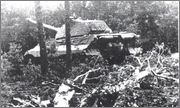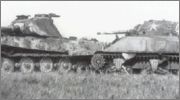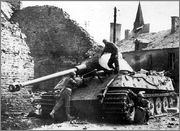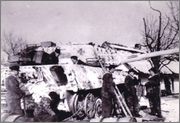As it appeared Sweden had King Tiger! It was restored to the running conditions and then used for training and learning. The running unit existed till 1949, then it was shoot out with rocket and grenade launchers. The gun KwK43 kept till late 1980, then scrapped.
The whole story: The "Swedish" PzKpfw. VI Ausf. B Königstiger
http://www.achtungpanzer.com/the-swedish-pzkpfw-vi-ausf-b-knigstiger.htm
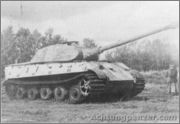
Did you know that Sweden in fact tested plenty of German WW2 AFVs after the war had ended?
No? I guessed so..well, here is a short story on the "Swedish" SdKfz. 182 "King Tiger"…
A Swedish delegation was sent to France in 1946, with the purpose to investigate and commission German WW2 AFVs. A visit took place in Versailles where a depot with Panther tanks was inspected. Most of them were meant to be scrapped, while others had been sold. The Swedish delegation was offered to choose between three Panther tanks. The French State reported that they were willing to give away the Panther, and so the one in best condition was chosen. (This Pz.Bef.Wg. Panther Ausf. A was then shipped to Sweden and tested until 1961 when it was given to the Panzermuseum Munster in Germany, where it is on display today). In the same time as the inspection of the Panther tank was made, selected Swedish officers followed a group of French officers to Normandy on October 4th 1946, looking for a Tiger. They traveled through Nantes, Evreux and Lisieur to the Vimontiere area. A totally burnt out King Tiger (of sPz.Abt. 503, 1. Kompanie) was found, but since Sweden wanted to perform AT-mine and firing trials upon it, this Tiger was overlooked. The French promised to continue the search for a suitable vehicle, not costing Sweden a dime. By the end of August of 1947, the military attaché in Paris claimed that a Tiger II has been found in good condition (no damage from fire). It was located in Gien, south of Paris.
Scandinavian Express was ordered to have the King Tiger transported to KAFT in Stockholm. On November 27th of 1947, the King Tiger was loaded off in Stockholm harbor. It was then being sent to the P4 regiment in Skövde. According to Inventory reports of P4 in December 1947, the King Tiger was there. As the workshop finally started to restore it a German egg-type handgrenade was found in the engine room. It had never detonated, presumably the tank had been quickly abandoned on the battlefield. The handgrenade was removed and blown up nearby in the workshop area. The engine was replaced, and the King Tiger was prepared for its first driving tests.
It was soon tested in the workshop area, by the impressed workers. During these early tests, the arm holding the idler wheel was damaged as one in the group steered to roughly in sand outside the workshop. It was quickly fixed, but now people had to be more careful as the program was changed. The transport to PcK in Karlsborg (testing area) was delayed due to this accident. Between September 24th and September 29th 1948, the King Tiger was to be moved from P4 regt. to PcK in Karlsborg, on rail to the village of Finneröja and there from on road to PcK. This was never realized due to the accident with the idler wheel arm that was broken earlier. Then it became a towing/recovery transport instead. A M26 "Dragon Wagon" truck was then needed. On November 11th 1948, it was suggested to remove the 88mm KwK43 L/71 before firing trials were made on the King Tiger. Eventually, there were possibilities in the future to buy 88mm ammo, enabling Sweden to perform tests with this potent weapon as well. The transport took place between November 10th and November 15th 1948. It should be seen as one of the toughest road transports ever made in the country of Sweden, and only the exact planning and performance of the people involved enabled the transport to be realized. Just outside the entrance road to PcK, it was decided to make a shortcut right through the woody area, instead of cornering a 120-degree crossroad, which most probably had totally ruined the road. The damage made to the woods cost them only 30:- SEK, while a 120 degree cornering on paved road would have caused a lot more material damage and expenses. The total cost of the transport was estimated to about 10.000:- SEK. The total weight of the transport was 160 tons, some 1.700hp was involved and 6.000 liters of gasoline were used up. The length of the transport totaled 60km, and the involved vehicles were:
1 x M4 Sherman (w/o turret)
1 x M26 Dragon Wagon (truck only)
1 x Terrängdragbil (Tgb) m/46
1 x 10-ton Recovery vehicle
1 x Fuel truck
2 x Automobiles for personnel
4 x Motorcycles
In mid-April of 1949, it was decided that firing trials were to be made on the King Tiger and a Sherman tank with various weapons and mines. During November and December of 1949, various tests were made with rocket and grenade launchers, and the new Swedish Pvkv m/43 tank destroyer tried its 75mm gun on both the King Tiger and Sherman tanks. It is said that after the tests were finalized, the remains of the King Tiger could have been loaded in the back seat of an old VW "Bug". This is partially true, it was really shot up far beyond repair. The hull was scrapped, while the turret was sent to the exercise field at Kråk, where it was shot up during various training missions. The 88mm KwK43 L/71 was kept in a depot at PcK. It was later sent to Bofors in Karlskoga, where it remained until late 1980′s. It was scrapped approx. 14 days before staff personnel from the Swedish Armour Historical Society (SPHF) asked about it. Had they have been 3 weeks earlier, this gun could eventually have been on display in the Swedish Armor Museum at Axvall today.
The whole story: The "Swedish" PzKpfw. VI Ausf. B Königstiger
http://www.achtungpanzer.com/the-swedish-pzkpfw-vi-ausf-b-knigstiger.htm

Did you know that Sweden in fact tested plenty of German WW2 AFVs after the war had ended?
No? I guessed so..well, here is a short story on the "Swedish" SdKfz. 182 "King Tiger"…
A Swedish delegation was sent to France in 1946, with the purpose to investigate and commission German WW2 AFVs. A visit took place in Versailles where a depot with Panther tanks was inspected. Most of them were meant to be scrapped, while others had been sold. The Swedish delegation was offered to choose between three Panther tanks. The French State reported that they were willing to give away the Panther, and so the one in best condition was chosen. (This Pz.Bef.Wg. Panther Ausf. A was then shipped to Sweden and tested until 1961 when it was given to the Panzermuseum Munster in Germany, where it is on display today). In the same time as the inspection of the Panther tank was made, selected Swedish officers followed a group of French officers to Normandy on October 4th 1946, looking for a Tiger. They traveled through Nantes, Evreux and Lisieur to the Vimontiere area. A totally burnt out King Tiger (of sPz.Abt. 503, 1. Kompanie) was found, but since Sweden wanted to perform AT-mine and firing trials upon it, this Tiger was overlooked. The French promised to continue the search for a suitable vehicle, not costing Sweden a dime. By the end of August of 1947, the military attaché in Paris claimed that a Tiger II has been found in good condition (no damage from fire). It was located in Gien, south of Paris.
Scandinavian Express was ordered to have the King Tiger transported to KAFT in Stockholm. On November 27th of 1947, the King Tiger was loaded off in Stockholm harbor. It was then being sent to the P4 regiment in Skövde. According to Inventory reports of P4 in December 1947, the King Tiger was there. As the workshop finally started to restore it a German egg-type handgrenade was found in the engine room. It had never detonated, presumably the tank had been quickly abandoned on the battlefield. The handgrenade was removed and blown up nearby in the workshop area. The engine was replaced, and the King Tiger was prepared for its first driving tests.
It was soon tested in the workshop area, by the impressed workers. During these early tests, the arm holding the idler wheel was damaged as one in the group steered to roughly in sand outside the workshop. It was quickly fixed, but now people had to be more careful as the program was changed. The transport to PcK in Karlsborg (testing area) was delayed due to this accident. Between September 24th and September 29th 1948, the King Tiger was to be moved from P4 regt. to PcK in Karlsborg, on rail to the village of Finneröja and there from on road to PcK. This was never realized due to the accident with the idler wheel arm that was broken earlier. Then it became a towing/recovery transport instead. A M26 "Dragon Wagon" truck was then needed. On November 11th 1948, it was suggested to remove the 88mm KwK43 L/71 before firing trials were made on the King Tiger. Eventually, there were possibilities in the future to buy 88mm ammo, enabling Sweden to perform tests with this potent weapon as well. The transport took place between November 10th and November 15th 1948. It should be seen as one of the toughest road transports ever made in the country of Sweden, and only the exact planning and performance of the people involved enabled the transport to be realized. Just outside the entrance road to PcK, it was decided to make a shortcut right through the woody area, instead of cornering a 120-degree crossroad, which most probably had totally ruined the road. The damage made to the woods cost them only 30:- SEK, while a 120 degree cornering on paved road would have caused a lot more material damage and expenses. The total cost of the transport was estimated to about 10.000:- SEK. The total weight of the transport was 160 tons, some 1.700hp was involved and 6.000 liters of gasoline were used up. The length of the transport totaled 60km, and the involved vehicles were:
1 x M4 Sherman (w/o turret)
1 x M26 Dragon Wagon (truck only)
1 x Terrängdragbil (Tgb) m/46
1 x 10-ton Recovery vehicle
1 x Fuel truck
2 x Automobiles for personnel
4 x Motorcycles
In mid-April of 1949, it was decided that firing trials were to be made on the King Tiger and a Sherman tank with various weapons and mines. During November and December of 1949, various tests were made with rocket and grenade launchers, and the new Swedish Pvkv m/43 tank destroyer tried its 75mm gun on both the King Tiger and Sherman tanks. It is said that after the tests were finalized, the remains of the King Tiger could have been loaded in the back seat of an old VW "Bug". This is partially true, it was really shot up far beyond repair. The hull was scrapped, while the turret was sent to the exercise field at Kråk, where it was shot up during various training missions. The 88mm KwK43 L/71 was kept in a depot at PcK. It was later sent to Bofors in Karlskoga, where it remained until late 1980′s. It was scrapped approx. 14 days before staff personnel from the Swedish Armour Historical Society (SPHF) asked about it. Had they have been 3 weeks earlier, this gun could eventually have been on display in the Swedish Armor Museum at Axvall today.
Last edited by lockie on Thu Apr 16, 2015 9:25 pm; edited 1 time in total









